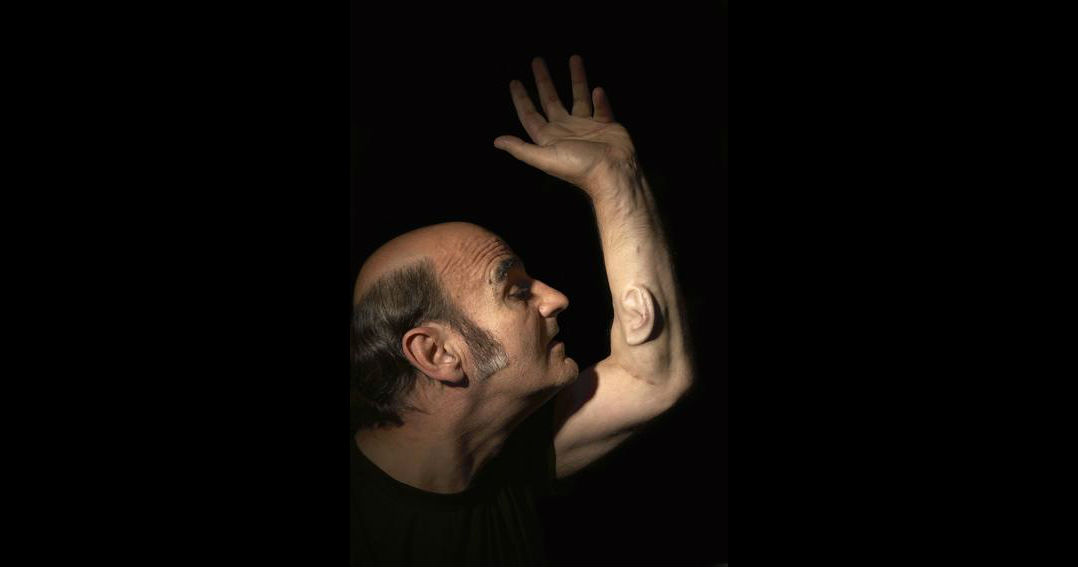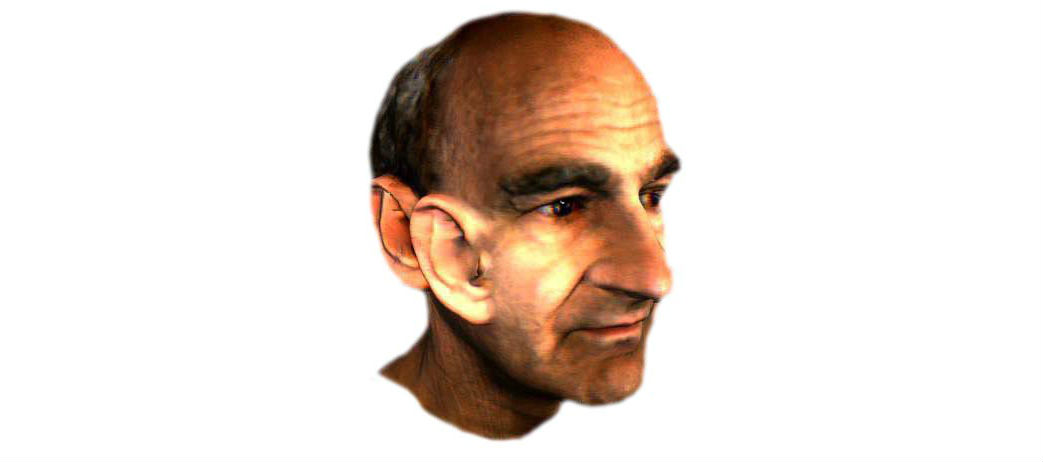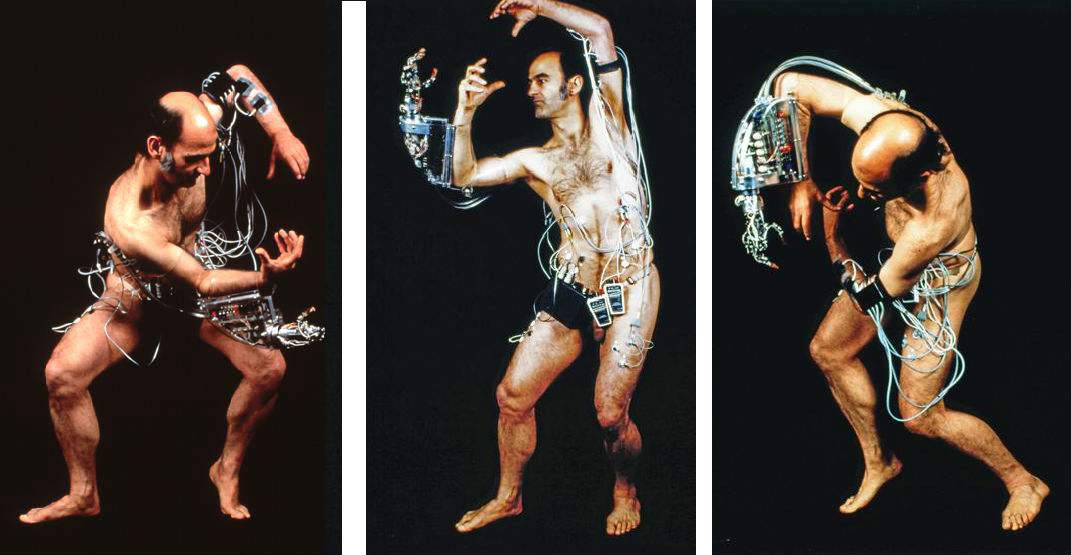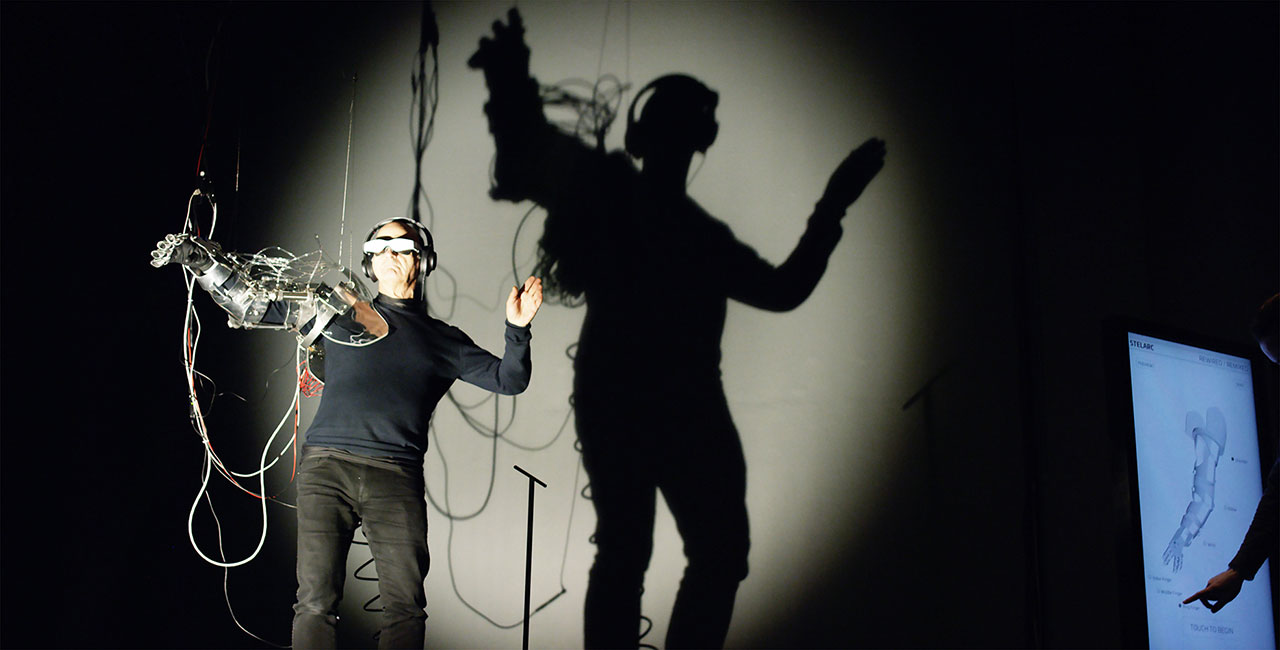Man made his third ear for the whole world to use - for the sake of art

Photo: Stelarc.org Last
weekend in Moscow, the GeekPicnic festival took place. One of his headliners was Stelark, a 73-year-old artist, author of many performances, and an honorary professor of art and robotics at Carnegie Mellon University.
He became famous in the 70s, when several times he hung himself on hooks in museums and public spaces. In the 80s, together with a team of scientists, Stelark developed a wearable exoskeleton with a mechanical arm that obeyed muscle signals. For its time, the hand was one of the most advanced devices in the industry. About performances, Stelark wrote an essay by William Gibson himself - one of the fathers of cyberpunk.
But perhaps the artist’s most famous project is an ear, which he surgically constructed on his arm and now plans to connect it to the Internet. We talked with Stelark and found out how the project is progressing.
In 1996, a man named Stelark decided to "grow" a third ear on his head. He was fond of anatomy, was a professor of art and robotics, and was famous for creepy performances. For example, he once installed a miniature sculpture inside his stomach, which viewers could look at with a camera.
The project with an ear, like everyone else, Stelark did not start for the development of medicine, surgery, science, transplantology and other utilitarian things. He did this for the sake of art, because in the first place he considered himself an artist.
“The ear is a very beautiful design. I always thought that it should be part of the human face. But medical communities are conservative, even when it comes to neurosurgery and brain surgery. No surgeon will agree to conduct them if the patient has no pathological abnormalities. At the same time, we know that they are experimenting on the elderly, crippled and sick, because they can justify this by prolonging their lives, restoring their hearing or vision, treating Alzheimer or Parkinson. ”
In the 90s, the idea with an ear sounded even more impossible than now. But Stelark began to look for people who will help bring the idea to life, and found.

Ear on hand - how is it?
According to the initial plan, they wanted to construct an ear from cartilage material taken from the stelar chest. Surgeons did not agree to do this for the sake of art. Some showed interest, but later still refused. A little later, Stelark, along with several Australian scientists, raised a one-in-four copy of his ear. The artist’s cells were placed in a bioreactor, where a three-dimensional structure could develop using rotation. A temperature of 37 degrees was maintained in a sterile environment, and the ear was fed with nutrients every three to four days.
But this copy would not be suitable for transplantation on the human body. Many years have passed, and a similar technology remains experimental. “Now we can print tissue using the patient’s living cells, but the tissue is printed in layers, not in bulk structure. So far, this is just the beginning of the journey of producing parts of the human body, ”says Stelark.
“In order for the ear to remain alive, it is necessary to establish blood supply, and printing blood vessels is a big problem. Organs like the heart are even harder. It’s necessary not only to create a structure, but also to place it in a nutrient medium with the right temperature, stimulate it with electricity, establish blood supply, hope that the heart begins to beat - and only then transplant it. ”
The project with an ear was developed only after a few compromises. They decided to construct the organ on the arm, and use artificial cartilage instead of real cartilage. More than 20 years have passed since the idea arose, but the project has not yet been completed.
“This is not cosmetic surgery, where the surgeon is trying to give a different shape, for example, to your nose. There is nothing on hand, and you have to build the structure from scratch, ”says Stelark,“ This is not an easy process. It requires many operations and stretches for many years. I spent ten years searching for financing and three surgeons who would agree to participate in the project. ”
During the first operation, a silicone implant was implanted under the skin to form a “leather bag” for the future ear. But the operation led to necrosis, and the place for "construction" had to be moved again - from the outside of the forearm to the inside.
During the second operation, an ear-shaped structure made of porous biocompatible polyethylene was implanted into the hand. The pore diameter of this material varies from 100 to 250 micrometers, and thanks to them, blood vessels, tissues grow through the structure, and the organ is tightly integrated into the hand.
Now the main surgical problem of the project is to grow a soft lobe on the third ear with the help of stem cells and graft it to the sink. In some countries, such as the United States, this is prohibited. The procedure was carried out in Europe, but it ended unsuccessfully. “You perform the operation, and then you wait a year - only to understand whether it worked or not. And since this is an experiment, there are no guarantees. ”
Behind the construction of the ear itself is another technically complex aspect. Stelark plans to implant a microphone in the sink to allow people to connect and listen to the same thing he does.

How to connect a microphone inside the body to the entire Internet
It was more difficult to fill a live ear with working electronics than you might imagine. “Now people watch science fiction films, read about the latest research, and their ideas are distorted. Realizing fantastic ideas in real life is not so easy, ”says Stelark.
“There are problems in putting a microphone inside without external wires, putting in batteries and necessary boards. We are not talking about a small chip that is paid at the box office, but about a whole Wi-Fi system. When you sew a microphone under your skin, you need to build something like an auricle above it so that it can perceive sound. It is necessary to provide how to charge the battery inside the ear. Theoretically, it is possible, but to make everything miniature and fit inside the sink is a serious problem. This is very difficult, even starting with just convincing the surgeon to get down to business. And we also planned to introduce GPS sensors so that the listener could understand where the ear is now. ”
The stelar was implanted with a microphone during one of the operations. For some time it worked fine - the sound was transmitted wirelessly and was pretty clear, despite the bandages over the ear. But at that time, not all systems were wireless - wires literally stuck out from under the skin. A few weeks later, an infection began on the arm. Surgeons urgently had to perform another operation to remove the microphone. However, they miraculously kept the ear alive.

Is there any practical benefit for everyone?
Stelark says he is not interested in practical and utilitarian use. “An artist is not about good. It's about imaginary, intuitive, aesthetic gestures. ”
But after the surgery site was moved to the inside of the forearm, science and medicine benefited. In 1996, surgeons told Stelark that such operations had never been performed. “But it turned out that in the second operation the ear construction was created on the most anatomically safe part of the body. Since then I have heard of three or four similar procedures. The ear was reconstructed on the patient’s arm so that it could then be transplanted onto the head - if, for example, the organ was lost in an accident or was completely absent from birth, ”says Stelark,“ This is all interesting, but not so important for me. No need to justify art by attributing utilitarian achievements to him. ”
If artists do not pursue profit, then at least look for meaning. The third-ear project began as a reflection on the obsolescence of the human body and the deliberate move beyond the architecture that evolution created. Now Stelark’s third ear is an attempt to make an Internet organ and proclaim that the human mind is no longer localized within a single biological body. It can be distributed over the bodies of other people.
“The more performances I make, the less sure that there is a certain mind in the usual metaphysical sense. Intelligence is just a word. Wittgenstein once said that thinking is not necessarily located in the head; it continues in the lips when we speak, in the hands with which we write. You cannot write a book only in your head. Thinking is a mechanical process of translating floating thoughts into words and then into a medium - onto a computer screen or a sheet of paper. And presence during action is something that we ascribe to ourselves retroactively. But what’s important is not what’s inside someone’s head. What matters is what happens between us all. ”
One of Stelark’s latest performances is called RE-WIRED / RE-MIXED. During it, the artist was in the Museum of Modern Art of the Australian city of Perth and for six hours a day, five days in a row looked through a virtual reality helmet through the eyes of a man in London, listened through the headphones of a New Yorker, and wore a mechanical hand on the arm, which outsiders could remotely control using a graphical interface. Video and audio were broadcast on projectors for spectators to perform.

“The idea of performance is a distributed consciousness. You trust your senses to people who are far from you, but at the same time you share your presence with them. The body feels divided and distributed, as if there were several consciousnesses in you. And here is what interests me. Why do we act as a biological body in only one specific place? Why not share your body with people from other places? Why not interact with the world through the eyes and ears of others? To some extent, we are already doing this. You are in Moscow, I am in St. Petersburg, but we communicate in real time using wireless technologies. And the step was not so big - to put wireless technology in your head. In the near future, neuroimplants will allow us to communicate without screens and external devices. We can talk to others within ourselves. Constantly".
Practical use is also, in a sense, a philosophical concept. Why should we move science? To live better and better? Or just to move on and on. In any case, if you ask yourself “why” several times in a row, the thought will end up in a dead end or recursion, but there will be no answer. Perhaps - we need practical benefit in order to become happy in one moment. But Stelark this laugh only made laugh:
“What do you mean by“ happiness ”? Most technological, evolutionary, social achievements are the result of physically difficult tests, risky procedures and experiments. And they have nothing to do with the concept of "being happy." Of course, if all these developments bring us some pleasure as a side effect - excellent. But to be happy - in my opinion, this is the last thing we should think about. "
A full interview with Stelark will be released next week.
